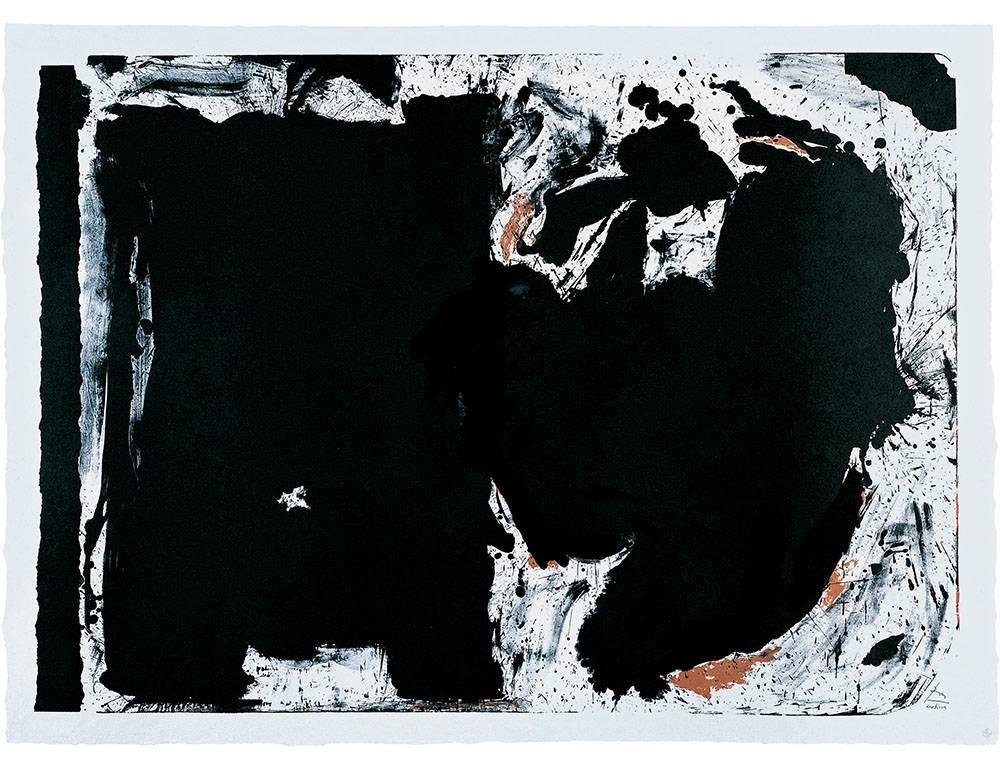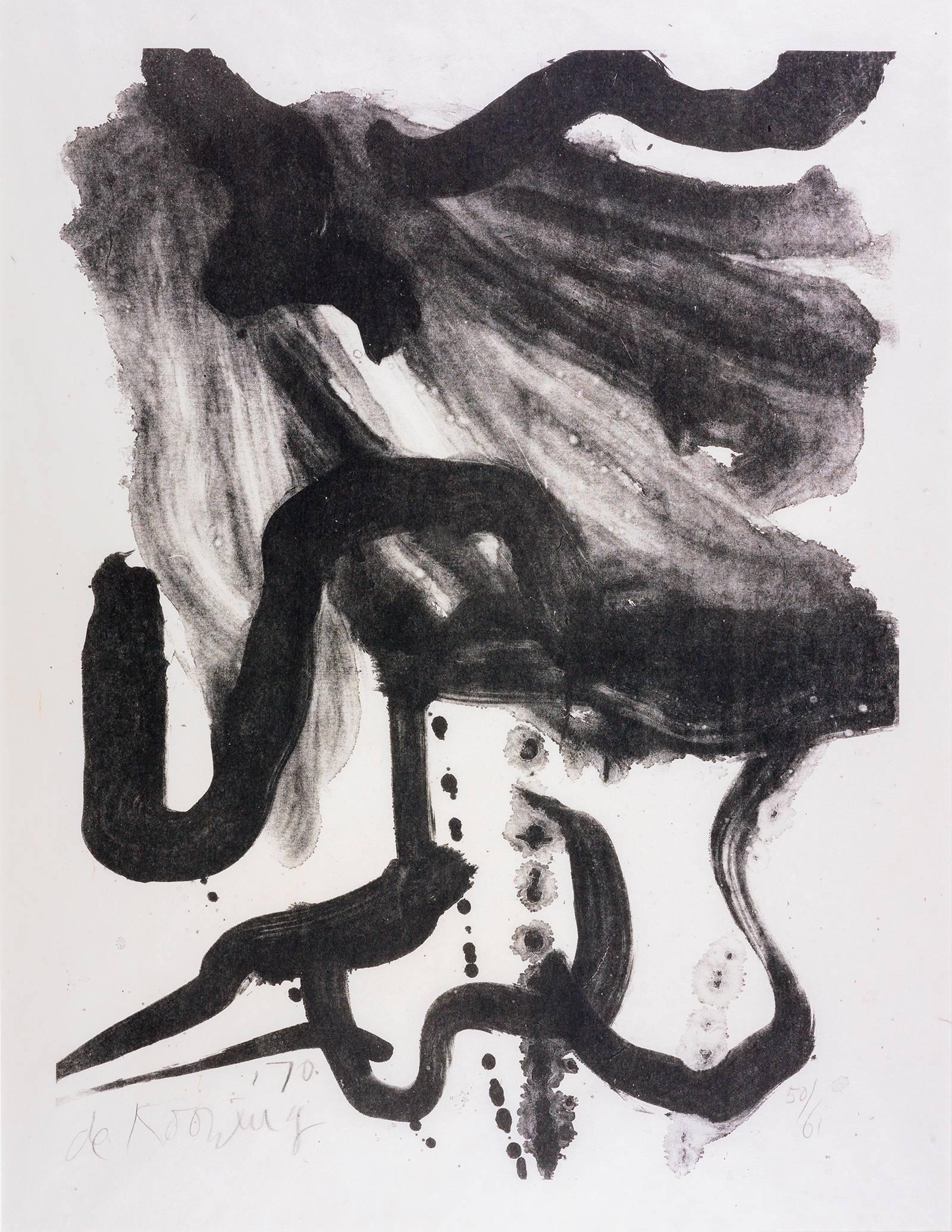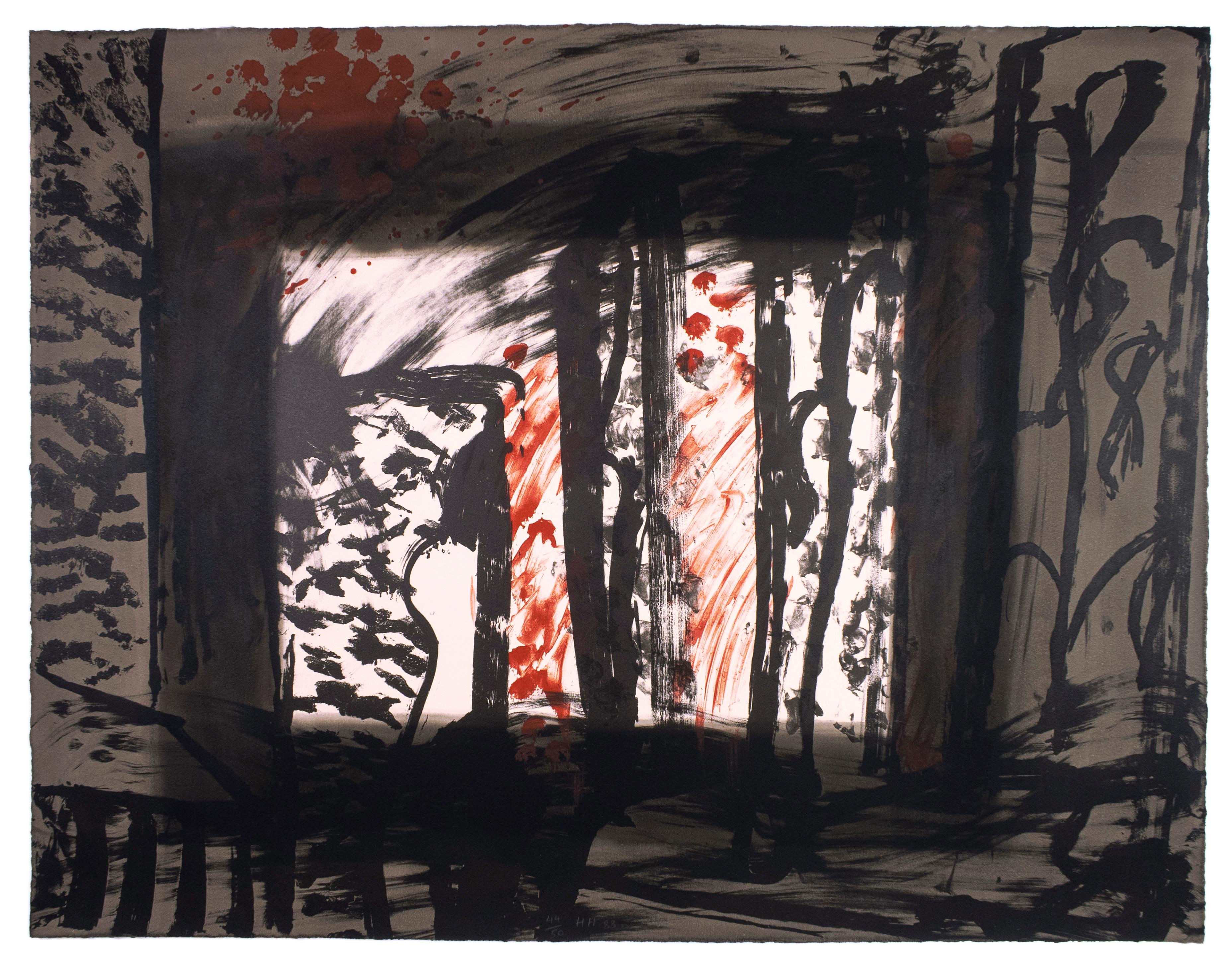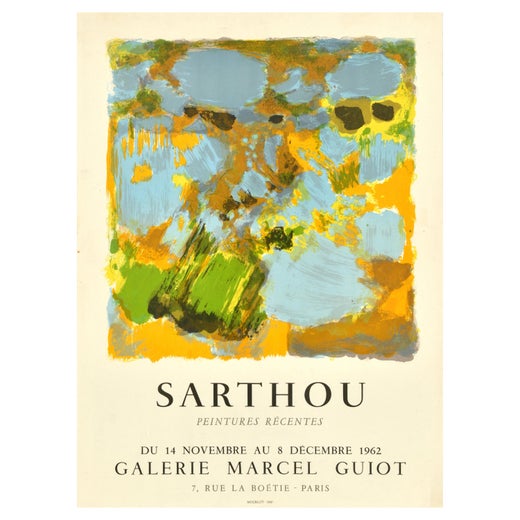Items Similar to Composition (Edition 209/220)
Want more images or videos?
Request additional images or videos from the seller
Maurice Élie SarthouComposition (Edition 209/220)Late 20th Century
Late 20th Century
About the Item
Maurice Élie Sarthou (French, 1911-1999) "Composition" Edition 209/220, Abstract Lithograph signed and numbered in Pencil, 18.50 x 24.63, Late 20th Century, ca. 1960s
Colors: Green, Black, Yellow, Purple, Orange
Sarthou was born in Bayonne on January 15, 1911; an orphan following the death of his father during the First World War, he was raised by his mother and grandfather in Montpellier. After high school, in 1927, he obtained the authorization to enter the Beaux-Arts of the city provided he prepared architecture. After a year, he persuades his family to let him study at the painting studio. He first attended a training at the School of Fine Arts in Montpellier; Then in 1930, a fellow of the city of Montpellier as the ward of the nation, he entered the Beaux-Arts in Paris.
In 1934, birth of Francine, his daughter. To make a living, he introduces himself to the drawing faculty. He was appointed to Bastia, then in 1937 to Bordeaux.
In 1939, 1940 and 1941, he made war in the transmissions.
In 1943, he became a member of the Société des Artistes Indépendants Bordelais, which regularly organizes exhibitions of Parisian artists (Bissière, Lhote, Walch, etc.); this has a positive influence on him; Artistic emulation allows him to assert his style even more intensely.
In 1948 he met the writer Raymond Guérin who introduced him to Maurice Toesca, Marcel Arland and, later, Jean Paulhan. In 1950, he illustrated Raymond Guérin's book "Testamentary fragment".
In 1949 he was chosen by Jacques Lassaigne, who came to Bordeaux to preside over the regional selection of the Prix de la Jeune Peinture. He won the price Drouant, the first mention of the price (fourth prize on more than 90 competitors, including Lagrange, Lapoujade, Rebeyrolle, also mentioned). In the jury, Gaston Diehl noticed him and invited him to the Salon de Mai of which he is the founder. It is the first manifestation of Sarthou with the Parisian public with two paintings: "Still life" and "Open window". He will participate in this show until 1963.
He moved to Paris in 1950, where he was appointed professor of drawing at Lycée Henri IV, which allowed him to exhibit in the salons of the capital and to be more recognized.
From 1950, around Jean Paulhan, meet at the arena of Lutetia, on Sunday morning, to play bowls: Maurice Toesca, Jerome Lindon, Yves Berger, Claude Simon, Andre Bay, Marcel Jouhandeau, Sarthou ..., exciting moments for the painter immersed in the literary milieu of Paris.
François Desnoyer, whom he met in 1951 at the Salon de Mai, introduced him to the Parisian merchant Marcel Guiot. Between the merchant and the artist a long relationship of friendship is established; from 1955 Sarthou regularly exhibits his new works in the gallery of Marcel Guiot to which he will remain faithful.
Over time, many museums in France and abroad, as well as other institutions (Regional Council of Languedoc-Roussillon, Maisons de la Culture, etc.) devoted retrospective exhibitions to him.
He also participates in many exhibitions: Salon de mai from 1949 to 1963; Fall Salon from 1951 to 1987; Salon Comparisons from 1957 to 1988; Painters witnesses of their time from 1955 to 1960; The group of 109 from 1983 to 1989; The Grands Prix of the Biennale de Menton from 1955 to 1970; The Biennial of Yvelines from 1974 to 1987; etc.
Finally he presents his works in numerous group exhibitions.
In 1952, after his arrival in Paris, he abandoned the Basque coast and the Arcachon basin in favor of Languedoc and Provence. He settles in Sète where he finds the light of the South: he tackles the themes of pines in the Mistral, bulls in the Camargue, the rocks of Les Baux, fishing villages on the pond and, later, fires.
In 1953 he won second prize Bührle; a year later, the second prize of the Dome, awarded by a jury composed solely of painters: Jacques Villon, Desnoyer, A.Lhote, Pignon, Singier, Chastel, etc. Then in 1955 the price of the Critique and, in 1957, the First Prize of the City of Menton to the Biennial; thereafter, in 1980, the First Grand Prix of the 7th International Biennial of Mérignac and, in 1985, the Grand Prix of the Orangery at the Château de Versailles.
In 1956 he painted the portrait of André Chamson for "The painters witnesses of their time".
In 1958 he left the teaching of drawing to focus on his painting.
In 1961 Jean-Albert Cartier organizes an exhibition "Ten French painters around Jacques Villon" at the Palais de la Méditerranée in Nice; on this occasion Jean Paulhan writes for Sarthou a very beautiful preface. This exhibition will then become itinerant, notably at the Museum of Fine Arts in Nancy, Tours and Luxembourg.
In 1962 the publisher Jacques Vialetay asked him to illustrate "Lou Biou" Baroncelli. He executed two stained glass windows for the church of Bouchevilliers in Reims, in the workshop of the master glassmaker Simon, one of which, in the apse, is next to a stained glass window by Jacques Villon.
In 1964, brought together by a common ideal on the Camargue, he sympathizes with the photographer Lucien Clergue, met in Arles. The two couples, Lucien and his wife Yolande, Sarthou and Dora, will remain very friends until the death of Sarthou in 1999 and Dora in 2002. In Arles he meets Michel Tournier who will write on him several texts including a preface for the exhibition at the Findlay Gallery in New York in 1974.
In 1966 he illustrates "Regards sur la mer" by Paul Valéry (Editions Vialetay); Agathe Rouart-Valéry presents his father's book with a foreword. At the request of the Norman Society of Friends of the Book, he illustrated in 1967 "The drunk boat" Arthur Rimbaud.
In 1972, on September 25th, began the filming for FR3 Toulouse "Sarthou or the painter of the elements" on an idea of Marc Alyn and Madeleine Attal, directed by Josée Dayan.
In 1976 he was part of the French delegation for the traveling exhibition in Japan "Selection of the Autumn Salon of Paris" Contemporary Masters "-Exposition Nika-Kai". His flight by the pole inspired him a new theme: the ice floe.
In 1977, at the inauguration of the Center Georges Pompidou, is exposed to the cabinet drawings a preparatory wash for his canvas "The dunes", acquired by the State.
His works are present in many museums and institutions, including the National Fund of Contemporary Art in Paris-La-Défense, the National Museum of Modern Art, the Museum of Modern Art of the City of Paris, the Library National Museum of France in Paris, the National Museum of History and Art of Luxembourg, the Museum of Art and History of Geneva, the Standford University in San Francisco, the Museum of the Princeton University, the Cincinnati Art Museum , the Sofia Museum, the Fabre Museum in Montpellier, the Toulouse-Lautrec Museum in Albi, the Musée Réattu in Arles and the Paul Valéry Museum in Sète ...
During his artistic career Sarthou has completed more than 1700 oil paintings, nearly 900 watercolors, gouaches, wash drawings, pastels, more than 100 lithographs, illustrated books, tapestries, stained glass, and wall decorations .
Maurice Elie Sarthou creates a sensory painting; he is at the hinge of figuration and abstraction ... This "transposed reality", according to his expression, places him, among the New School of Paris, in the movement of "allusive figuration" and brings him closer to abstraction. lyrical.
As wrote Pierre Georgel (Curator General of Heritage, Historian of art), in the preface of the Sarthou exhibition at the Paul Valery Museum in Sète in 1973: "Of the work of Villon, he retained the essential : the lyrical vision of nature, expressed by a colored geometry, resulting from the Orphism and the Golden Section. Villon also loved his painting a lot: he told me so many times and I am happy to testify ...
Picasso said: "It takes a long time to become young." Sarthou was lucky enough to know or find the fire of adolescence at the age when others are sclerosing. He has spontaneity and ardor, without clumsiness. Instinct, no doubt, gives rise to spurts, splashes, streaks, snotches of paint which sometimes make his paintings look like the most beautiful successes of gestural tachism, but instinct would not suffice. Here comes the reference - distant, intuitive, but constant - to nature »
Sarthou dies in Paris on June 11, 1999; he is buried at the Sète Marine Cemetery. Dora, his wife, who died in Sète on December 11, 2002, rests with him.
- Creator:Maurice Élie Sarthou (1911 - 1999)
- Creation Year:Late 20th Century
- Dimensions:Height: 18.5 in (46.99 cm)Width: 24.63 in (62.57 cm)
- Medium:
- Movement & Style:
- Period:
- Condition:
- Gallery Location:New York, NY
- Reference Number:1stDibs: LU75233478911
Maurice Élie Sarthou
null
About the Seller
4.6
Vetted Seller
These experienced sellers undergo a comprehensive evaluation by our team of in-house experts.
Established in 1984
1stDibs seller since 2017
84 sales on 1stDibs
Typical response time: <1 hour
- ShippingRetrieving quote...Ships From: New York, NY
- Return PolicyThis item cannot be returned.
More From This SellerView All
- Homage To Rousseau (Edition 72/300)By Ivel WeihmillerLocated in New York, NYIvel Weihmiller (Argentine b. 1954) , "Homage To Rousseau" Edition 72/300, Abstract Lithograph Print signed and numbered in Pencil, 26.75 x 21, Late 20th Century Colors: Orange, Blu...Category
Late 20th Century Abstract Abstract Prints
MaterialsLithograph
- Familie (Edition 34/100)Located in New York, NYUnknown/ Unidentified Artist, "Familie" Edition 34/100, Abstract Figurative Lithograph signed and numbered in pencil, 15.25 x 21, Late 20th Century, 1967 Colors: Red, Blue, Yellow, ...Category
1960s Abstract Abstract Prints
MaterialsLithograph
- One on One (Artist Proof)By Harvey KonigsbergLocated in New York, NYHarvey Konigsberg ( American b. 1940 ) "One on One" (Artist Proof), Figurative Abstract Lithograph, 30 x 21, Late 20th Century Colors: Black and White Harvey Konigsberg was born in...Category
Late 20th Century Abstract Abstract Prints
MaterialsLithograph
- The Wedding ( Edition 270/300 )By George StauchLocated in New York, NYGeorge Stauch (American b. 1900), " The Wedding" Edition 270/300, Abstract Color Lithograph signed in pencil, 20 x 24, Late 20th Century Colors: Blue, White, Red, Brown, Y...Category
Late 20th Century Abstract Abstract Prints
MaterialsLithograph
- Spider Mums (Edition 301/325)By Hari HockeyLocated in New York, NYHari Hockey (American), "Spider Mums" Edition 301/325, Abstract Still Life signed and numbered in pencil, 28.50 x 22, Late 20th Century Colors: Purple, Orange, Red, Blue, Black, BrownCategory
Late 20th Century Abstract Impressionist Still-life Prints
MaterialsLithograph
- Untitled (Edition 45/100)By Georgi DaskaloffLocated in New York, NYGeorgi Daskaloff (Bulgarian b. 1923), "Untitled" 45/100, Abstract Lithograph numbered and signed in pencil, 30 x 22.25, Late 20th Century Colors: Blue, White, BlackCategory
Late 20th Century Abstract Abstract Prints
MaterialsLithograph
You May Also Like
- Lament for LorcaBy Robert MotherwellLocated in London, GBLithograph on white Tyler Graphics Ltd. (TGL) handmade paper 44x61 in (111.8x154.9cm) Edition of 52Category
1980s Abstract Expressionist Abstract Prints
MaterialsColor, Lithograph
- Seeing Voice Welsh HeartBy Paul JenkinsLocated in New York, NYA very good impression of this color lithograph on Rives BFK. Signed and numbered 30/40 in pencil. Printed by Mourlot, Paris. Published by Galerie Karl Flinker, Paris. From the same-...Category
1960s Abstract Expressionist Abstract Prints
MaterialsColor, Lithograph
- Derriere le Miroir Cover - Vintage Lithograph by Alexander Calder - 1968By Alexander CalderLocated in Roma, ITDerriere le Miroir Cover is an original artwork realized by Alexander Calder in 1968. Original mixed colored lithograph. The artwork was th...Category
1960s Abstract Abstract Prints
MaterialsLithograph
- Woman with Corset and Long HairBy Willem de KooningLocated in New York, NYPrinter: Hollanders Workshop, New York Publisher: Knoedler, New York Edition size: 61, plus proofs Catalogue Raisonné: Graham 17 Signed, dated, and numbered inpencil, lower marginCategory
1970s Abstract Expressionist Abstract Prints
MaterialsLithograph
- Cespuglio all’Adda - Lithograph by Ugo Maffi - 1974By Ugo MaffiLocated in Roma, ITCespuglio all’Adda is an original artwork realized by Ugo Maffi in 1974. Mixed colored lithograph. Hand-signed by the artist on the lower right. Numbered on the lower left margin....Category
1970s Abstract Abstract Prints
MaterialsLithograph
- Sand Howard Hodgkin abstract sepia black and white earth tone painting printBy Howard HodgkinLocated in New York, NYAbstract, large scale earth toned red, black, taupe and grey scene with dynamic lines, shapes and hand painted brushstroke texture. This dramatic Howard Hodgkin work is ideal for dis...Category
1980s Abstract Abstract Prints
MaterialsWatercolor, Lithograph
Recently Viewed
View AllMore Ways To Browse
Basin Japan
The Vintage Merchant
Cartier Yellow Glasses
Yellow Cartier Glasses
Two Stained Glass Windows
Picasso Glass Abstract
Green And Yellow Abstract Glass
Chateau De Versailles
Print Dome
La Mer Vintage
Maurice Green
1962 Black And Green
Maurice Jacque
Cartier Love Black
Vintage Window Cabinet
Selection Lithographs
Picasso Lithograph Mother
Vintage Stained Glass Cabinet






